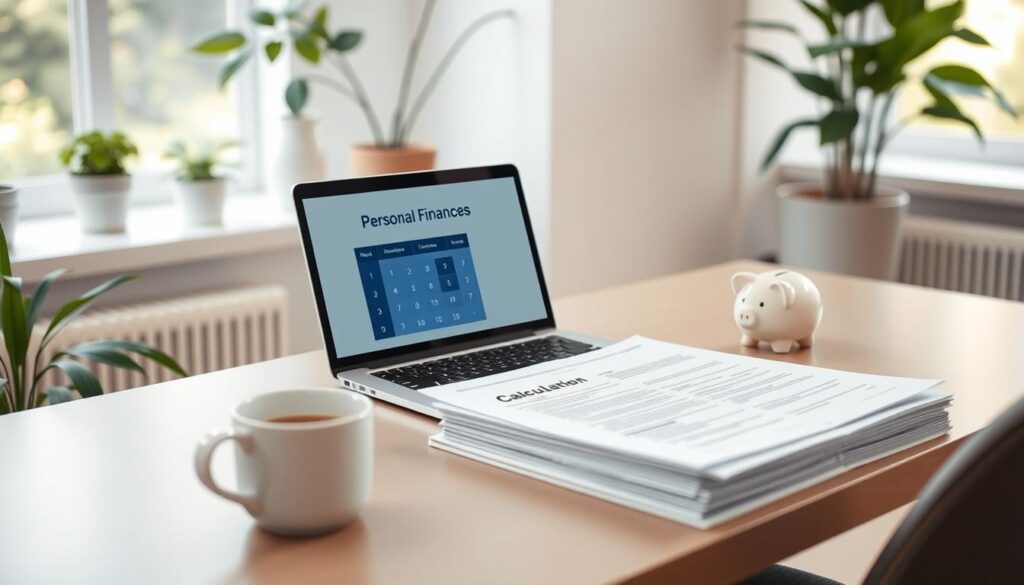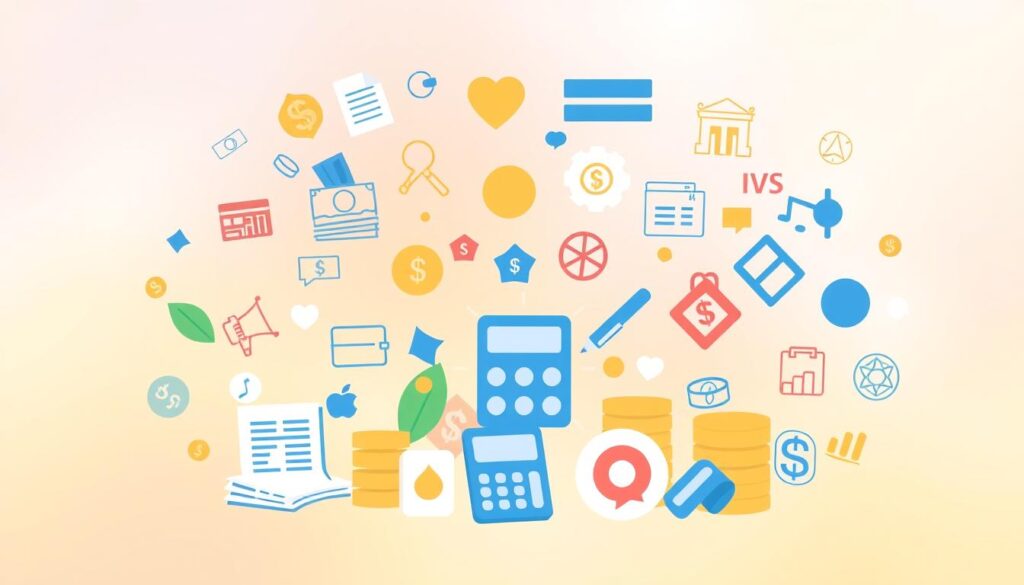Personal loans are a type of loan used for many things, like paying off debt or unexpected costs. They are known for their flexibility, helping with big purchases, debt consolidation, or one-time expenses. When looking for the best rates, online personal loans are worth checking out. They often have better terms and lower interest rates.
Personal loans usually have lower interest rates than credit cards, if you have good credit. But, knowing what affects loan approval is key. This includes your credit score and the loan amount. In this article, we’ll cover personal loans in-depth. We’ll talk about the best rates, online loans, and what to expect when applying.
Understanding Personal Loans: The Fundamentals
Personal loans help with debt consolidation or unexpected costs. They come in two types: secured and unsecured. Secured loans need collateral, while unsecured ones rely on your credit score. Knowing the difference is key when looking for quick personal loans.
For those with bad credit, personal loans for bad credit might be a choice. But, they usually have higher interest rates. On the flip side, low interest personal loans are better for those with good credit. Always compare rates and terms before deciding.

Personal loans are used for many things like paying off debt, improving your home, or for emergencies. You can borrow between $1,000 and $100,000. Repayment terms range from 1 to 7 years. Understanding personal loans helps you make better financial choices.
Key Factors That Influence Personal Loan Approval
When looking at personal loan options, it’s key to know what lenders look for. They check your financial health to see if you’re a good risk. A high credit score, steady income, and not too much debt are important. To compare personal loans well, apply to several lenders and look at the fine print.
Here are some main things lenders check:
- Credit score: A score of 630 or better is best for getting a loan.
- Income: More income means you’re likely to pay back the loan on time.
- Debt-to-income ratio: Lenders like it if this ratio is under 36%, but some might go up to 50%.
Knowing these points and comparing personal loan options helps you make smart choices. Keeping your credit score up, paying off debts, and providing the right documents are also key.

Every lender has its own rules, and rates can differ a lot. By doing your homework and comparing personal loan options, you can find the right loan for you.
| Factor | Influence on Approval |
|---|---|
| Credit Score | High credit score increases approval chances |
| Income | Higher income boosts approval chances |
| Debt-to-Income Ratio | Low debt-to-income ratio increases approval chances |
Types of Personal Loans Available Today
It’s important to know the different personal loan options. With an average debt of $19,402, finding the right loan is key. Instant personal loans offer quick access, but comparing rates is crucial for a fair deal.
There are many types of personal loans, each with its own pros and cons. You can choose from traditional bank loans, online loans, peer-to-peer lending, and credit union loans. Unsecured loans need good credit for the best rates, while secured loans might have lower rates due to less risk for lenders.
Traditional Bank Loans
Bank loans from banks and credit unions are secure and straightforward. They often have fixed rates and terms, making budgeting easier.
Online Personal Loans
Online loans are quick and convenient, with some offering instant approval and same-day funding. But, it’s important to compare rates and terms to avoid high costs.

- About 66% of personal loans are fixed-rate.
- Variable-rate loans might start lower but can change with the market.
- Debt consolidation loans can lower your interest rate compared to multiple debts.
| Loan Type | Interest Rate | Repayment Term |
|---|---|---|
| Traditional Bank Loan | Fixed | 1-5 years |
| Online Personal Loan | Variable | 1-7 years |
| Credit Union Personal Loan | Fixed | 1-10 years |
Knowing the different personal loans and comparing rates helps you choose wisely. This ensures you meet your financial needs.
How to Find the Best Personal Loan Rates
When looking for a personal loan, finding the best rates is key. Online personal loans make it easy to compare rates from different lenders. Look at interest rates, fees, and repayment terms. For example, quick personal loans might have higher rates but get you money faster.
To find top rates, compare offers from lenders like Upstart, Discover, and SoFi. Search for low interest personal loans with flexible payback plans. Some, like LightStream, offer rates as low as 6.99%. Here are some options:
- Upstart: $1K – $50K, 3 to 7 years, 7.80 – 35.99% APR
- Discover: $2.5K – $40K, 7.99 – 24.99% APR
- SoFi: $5K – $100K, 8.99 – 29.99% APR
Always check the loan’s terms and conditions, including fees and repayment plans. By comparing, you can find the perfect loan for your budget. About 50% of people get their money the next day after approval. Funds usually arrive in your bank in 1-3 business days after verification.
Getting the best personal loan rates takes time, research, and knowing your financial needs. By exploring online personal loans, quick personal loans, and low interest personal loans, you can make a smart choice and get the best rate for your loan.
Understanding the True Cost of Personal Loans
When looking at personal loans for bad credit, it’s key to know the real cost. This includes the interest rate and any extra fees. To compare loans well, you must look at the total cost, not just the initial offer.
The average interest rate for a 24-month personal loan was 12.33% as of August 2024, the Federal Reserve said. But, this rate can change based on your credit, loan amount, and term. Some lenders might also add origination fees, which can be 1% to 6% of the loan.
To understand the loan’s total cost, think about all fees and charges. This includes late fees, documentation fees, and penalties for paying off early. By comparing loans and looking at all costs, you can make a smart choice.
| Fee Type | Typical Range |
|---|---|
| Origination Fee | 1% to 6% of loan amount |
| Late Fee | $29 to $39 |
| Prepayment Penalty | Varies by lender |
Knowing the real cost of personal loans helps you make a wise choice. Always check the loan terms and conditions before you sign anything.
The Personal Loan Application Process
Applying for personal loans involves a few steps. First, you submit an application. Then, you provide necessary documents. After that, you wait for approval. Having a good credit score is key to getting the best personal loan rates.
Some lenders offer instant personal loans for urgent needs. But, these loans might have higher interest rates or fees. Always check the loan terms before applying.
Here are important things to think about when applying for a personal loan:
- Credit score: A good credit score can help you qualify for better interest rates and terms.
- Income: A stable income can increase your chances of approval and help you qualify for larger loan amounts.
- Debt-to-income ratio: A lower debt-to-income ratio can improve your chances of approval and help you qualify for better interest rates.
Understanding the personal loan application process is crucial. By carefully reviewing loan terms, you can make a smart choice. This way, you find the best option for your needs.
| Loan Type | Interest Rate | Loan Term |
|---|---|---|
| Personal Loan | 6.99% – 35.99% | 1 – 7 years |
| Instant Personal Loan | 10.99% – 35.99% | 1 – 5 years |
Important Documentation and Requirements
When you apply for personal loans, having the right documents is key. This makes the process smoother and faster. Online personal loans often have easy application processes. But, having the correct documents can speed up approval.
Income proof is a big part of the application. Lenders want to see pay stubs, tax returns, W-2s, and bank statements. Self-employed people might need to show tax returns for the last two years and 1099 forms. A steady income is important for getting online personal loans. Lenders look at your credit score and debt-to-income ratio to decide.
Required Documents
- Proof of identity (2 forms of identification)
- Proof of employment and income
- Proof of address (utility bills, lease agreements, mortgage statements)
- Personal financial information
To find the best personal loans, knowing about credit history and paperwork is crucial. Having these documents ready and a good credit score can help you get approved and get better rates. For example, Discover requires a minimum income of $25,000 for personal loans. By considering these factors and choosing the right lender, you can find the best loan for you.
| Document | Description |
|---|---|
| Pay stubs | Proof of income |
| Tax returns | Proof of income and financial stability |
| W-2s | Proof of employment and income |
Tips for Improving Your Chances of Approval
Getting a personal loan can be tough. But, there are ways to boost your approval chances. Your credit score is crucial. A good score means better rates and terms.
To better your credit score, pay bills on time and lower your debt. Make a budget, pay off high-interest debts, and avoid new credit checks. Online loans might be easier to get, but choose a reliable lender for the best deals.
- Checking your credit report for errors and disputing any inaccuracies
- Reducing your debt-to-income ratio to 36% or lower
- Applying for a secured personal loan, which may have looser borrowing requirements
- Shopping around for lenders that offer the best personal loan rates and terms
Follow these tips and keep a good credit score. This way, you’ll have a better shot at a loan with good rates. Always check the loan details before signing. If unsure, get advice from a financial expert.
Common Personal Loan Mistakes to Avoid
When you get quick personal loans, knowing common mistakes is key. Not comparing rates can lead to higher costs. Also, not reading the fine print can cause unexpected fees.
Here are some mistakes to steer clear of with low interest personal loans or personal loans for bad credit:
- Not checking your credit score before applying
- Not comparing rates and terms from different lenders
- Not reading the fine print and understanding the terms and conditions
- Not considering the total loan cost, including interest rates and fees
Avoiding these mistakes helps you get a good deal on personal loans for bad credit or low interest personal loans. Always compare rates, read the fine print, and think about the total cost before deciding.
Also, use online tools and resources to help you decide. With the right information and planning, you can find the best quick personal loans for your needs.
| Loan Type | Interest Rate | Fees |
|---|---|---|
| Quick Personal Loans | 10-20% | 1-5% |
| Low Interest Personal Loans | 6-12% | 0-3% |
| Personal Loans for Bad Credit | 15-30% | 2-10% |
Conclusion: Making an Informed Personal Loan Decision
Personal loans can be very helpful when used wisely. Knowing what affects loan approval and the costs of borrowing helps you make smart choices. This way, you can reach your financial goals.
Looking to pay off debt, buy something big, or cover an unexpected cost? Look at instant personal loans, rates, and repayment plans carefully. Your credit score, income, and debt-to-income ratio matter a lot for loan approval and terms.
With the advice from this guide, you can confidently explore personal loans. This will help you make choices that improve your financial future. Take charge of your finances today by making informed decisions.

